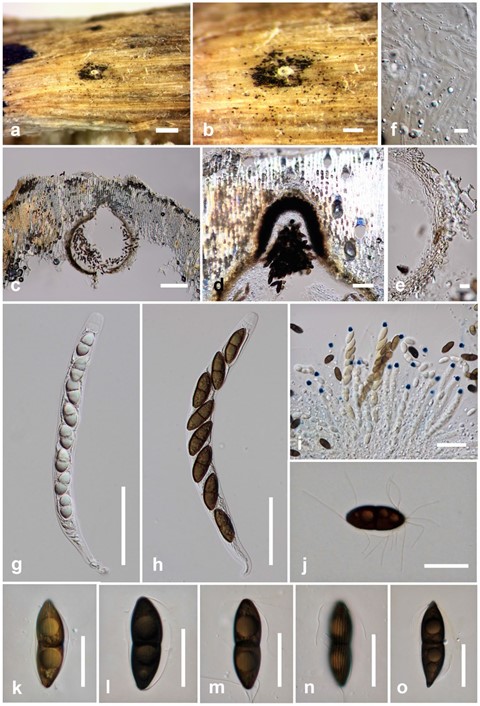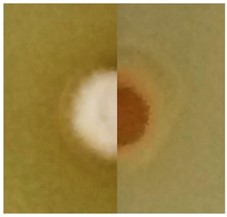Longiappendispora chromolaenae Mapook & K.D. Hyde, in Mapook, Hyde, McKenzie, Jones, Bhat, Jeewon, Stadler, Samarakoon, Malaithong, Tanunchai, Buscot, Wubet & Purahong, Fungal Diversity 101: 141 (2020).
MycoBank number: MB 557337; Index Fungorum number: IF 557337; Facesoffungi number: FoF 07842; Fig. 128
Etymology – Name reflects the host genus Chromolaena, from which this species was isolated.
Holotype – MFLU 20-0320
Saprobic on dead stems of Chromolaena odorata. Sexual morph: Ascomata 500–580 µm high × 360–505 µm diam. (x̄ = 535 × 440 µm, n = 5), immersed beneath clypeus, unilocular, globose to subglobose, coriaceous, solitary or scattered, sometimes gregarious. Ostiole central. Peridium (15–)20–30 µm wide, comprising 2–3 layers, pale brown to hyaline cells of textura angularis. Hamathecium comprising 2–4 µm wide, cylindrical to broadly filiform, septate, guttulate, hyaline paraphyses, embedded in a gelati- nous matrix. Asci 140–230 × 13–20 µm (x̄ = 195 × 15.5 µm, n = 15), 8-spored, unitunicate, cylindrical to broadly filiform, short pedicellate, straight or slightly curved, with an apical ring, apically rounded. Ascospores 28.5–43 × 9.5–12 µm (x̄ = 33 × 11 µm, n = 30), uniseriate, hyaline when immature, becoming brown to dark brown when mature, 1-septate, ellipsoid to broadly fusiform, tapering towards narrow ends, constricted at the septum, straight or slightly curved, guttulate at both cells, with longitudinal striations and bristle- like polar appendages from both ends, without a gelatinous sheath. Asexual morph: Undetermined.
Culture characteristics – Ascospores germinating on MEA within 24 h. at room temperature and germ tubes produced from both ends. Colonies on MEA circular, mycelium raised and velvety with moderately fluffy, filamentous, white aerial hyphae at the surface and orange in reverse with white yellow at the margin (Fig. 129).
Pre-screening for antimicrobial activity – Longiappendispora chromolaenae (MFLUCC 17-1485) showed antimicrobial activity against E. coli with a 9 mm inhibition zone when compared to the positive control (9 mm), but no inhibition of B. subtilis and M. plumbeus.
Material examined – THAILAND, Chiang Rai Province, Doi Pui, on dead stems of Chromolaena odorata, 2 February 2017, A. Mapook (DP83, MFLU 20-0320, holotype); ex-type culture MFLUCC 17-1485.
GenBank numbers – LSU: MT214464, ITS: MT214370, SSU: MT214417
Notes – In a BLASTn search of NCBI GenBank, the closest match of the ITS sequence of Longiappendispora chromolaenae (MFLUCC 17-1485, ex-holotype) with 84.88% similarity was Cainia desmazieri (strain CBS 137.62, MH858124), while the closest match with the LSU sequence with 96.99% similarity was Cainia graminis (strain CBS 136.62, AF431949).

Fig. 128 Longiappendispora chromolaenae (holotype) a, b Appearance of ascomata on substrate. c Section through ascoma. d Ostiole. e Peridium. f Pseudoparaphyses. g–h Asci. i–o Ascospores. Scale bars: a = 500 µm, b, c = 200 µm, d, g–i = 50 µm, j–o = 20 µm, e, f = 5 µm

Fig. 129 Culture characteristic on MEA: Longiappendispora chromolaenae (MFLUCC 17-1485)
